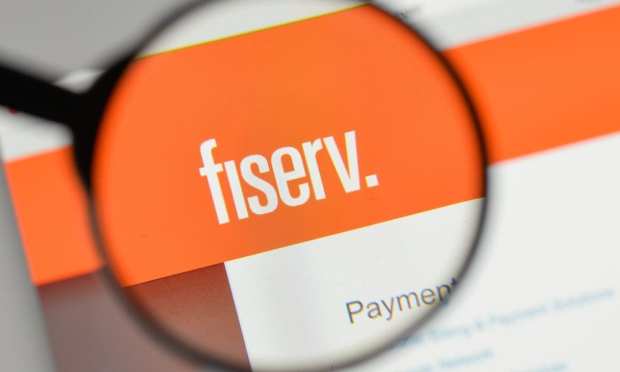Fiserv’s Yabuki Points To Payments Digitization Amid 4Q Sales Growth

Fiserv’s Q4 results were in line with a preliminary announcement, including 6 percent payments growth. As the deal with First Data sinks in and becomes an operational reality, and as banking mega-mergers dominate the headlines, Fiserv CEO Jeff Yabuki told investors that the digitization of payments and mobile banking are changing the financial services business. Fiserv and First Data are set to capitalize on numerous opportunities, he said. We break down the details.
Megadeals are everywhere in financial services — and leading up to the collaboration between First Data and Fiserv, the latter firm posted Q4 results that showed growth in key payment and processing initiatives, especially in digital efforts. As has been previously reported, a proposed $22 billion deal (slated to close later in the year) will bring the two firms together, where Fiserv holders will own 57.5 percent of the combined entity, and First Data holders the remainder.
For Fiserv, the headline numbers reported on Thursday (Feb. 7) evening showed that revenues were in line with expectations at $1.6 billion, and non-GAAP earnings were $.84, which missed the Street at $.85.
However, drilling down into results a bit, adjusted revenues were $1.47 billion. Internal revenues, defined in supplemental materials offered by the company, which excluded the impact on acquired or disposed operations, gained 4.5 percent. Internal revenue growth by segment showed that payments were up 6 percent to $944 million, while sales attributed to the financial segment gained 3 percent to $615 million.
Looking ahead, internal revenue growth for the year should be up between 4.5 percent to 5 percent, the company said.
Fiserv CEO Jeff Yabuki told analysts on the earnings conference call that key elements of the company’s strategy have focused, in part, on increasing the company’s internal growth rate, with the increase tied to recurring revenues. He said the quarter was marked by the firm’s largest accounts processing win “ever, enhancing our growth profile.”
Referring to the collaboration with First Data, Yabuki said “early client reaction has been extremely positive … the model is compelling, with leadership positions across multiple solutions.” He repeated the goals of $500 million in revenue synergies through a five-year period and $900 million in cost savings.
Client relationships, he said, are being enhanced with an emphasis on digital payments. Yabuki spotlighted the news on Thursday that New York Community Bank (NYCB), with more than $51 billion in assets, is converting to a real-time platform, marked by Fiserv’s digital banking and payment solutions.
As reported, NYCB is moving to DNA, which Fiserv has billed as its continuously available real-time core platform, built on open architecture and featuring its real-time Dovetail Payments Platform, Corillian Online and Mobiliti digital banking products. Overall, DNA performance was strong in 2018, noted Yabuki, with 30 implementations — 16 of those implementations done for institutions with assets greater than $1 billion.
“Interest also remains high for our digital and payment solutions,” said Yabuki, which include Architect and Commercial Center. He added that “as the world becomes more digital-centric, we are clearly in an environment that is real time.” In the case of the NYCB, he said the firm wanted the flexibility that comes with application programming interfaces (APIs).
He also noted that “we continue to see strong demand around Zelle,” where transactions there are up 75 percent year over year. The firm signed up nearly 100 new clients for Zelle in Q4, said the executive.
Fiserv CFO Robert Hau said that payments performance was led by strong results in billing solutions and card services, as well as traction in electronic payments. Organic debit transaction growth was up in the high single digits. Mobiliti subscribers grew 21 percent in the quarter to more than 8 million. Total peer-to-peer (P2P) transactions grew by 74 percent in the quarter, he added, and 44 percent for the year, “showcasing the strong growth potential” of these new payment technologies. The financial segment was driven by the processing businesses.
Yabuki noted that the domestic pipeline exiting 2018 “remains nearly 20 percent higher than at the same point last year.”
The overall market landscape, he said, is one where clients are moving toward payments, risk and “all things digital.” Market participants will be spending more on tech investments and data insights, coupled with the macro environment. He also said, “We believe M&A will continue to be active, an example of which you saw earlier today” with the news that BB&T would buy SunTrust in the biggest banking deal seen since the financial crisis.
The aforementioned internal revenue guidance for the year assumes no impact from the First Data deal, said Yabuki.
In reference to questions from analysts, Yabuki said the combined Fiserv/First Data entity will center around bank merchants and end-to-end payment opportunities, where clients have said “‘now that you guys are together, we want you to take a look at this business that we would not [have] otherwise done had [Fiserv and First Data] not come together.’”
